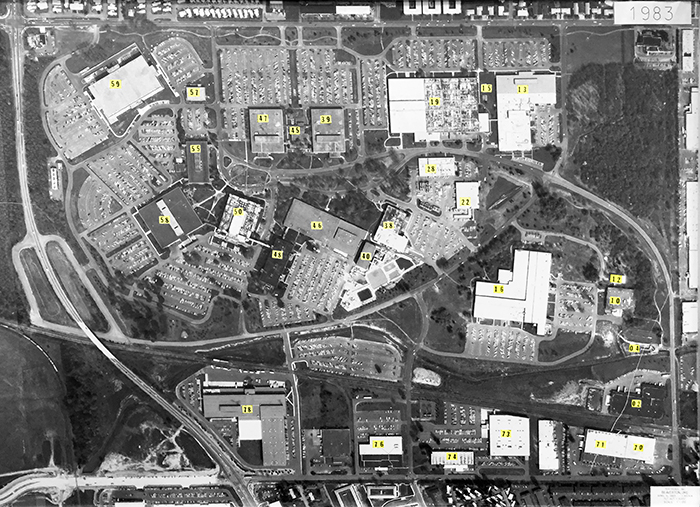As we continue to work our way through our archive of photos, we run across some that are a bit out of the ordinary. They may be humorous or unique but they stand out from the other photos. We post new photos here monthly with the previous photos in the slideshow.
Our December Photo of the Month is an aerial view of the Beaverton campus from April 2, 1980. Professional aerial photos were taken regularly of Tektronix properties and we at the museum are fortunate to have a large number of them. In 1980 Tek was nearing its peak headcount that came in 1982 with just over 24,000 worldwide employees. This is reflected in the extremely full parking lots seen in the photo. Note that Building 59 is still under construction in the NW (upper left) corner of the photo. That would be the last major new building that Tek would construct on the campus. Click on the image to view a high resolution PDF.
There were 28 numbered buildings. These are identified in the additional photo from 1983. Click on the image to view a high resolution PDF.
Here are links to aerial photographs on the museum website: Beaverton Wilsonville Sunset
Photos of the Month: Jan 2025 - Present
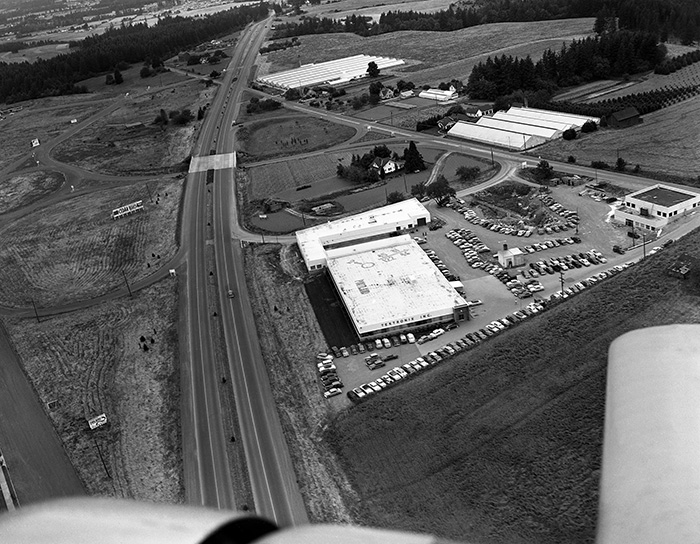 Jan 2025 POM: Earliest photo of Sunset - late 1951/early 1952
Jan 2025 POM: Earliest photo of Sunset - late 1951/early 1952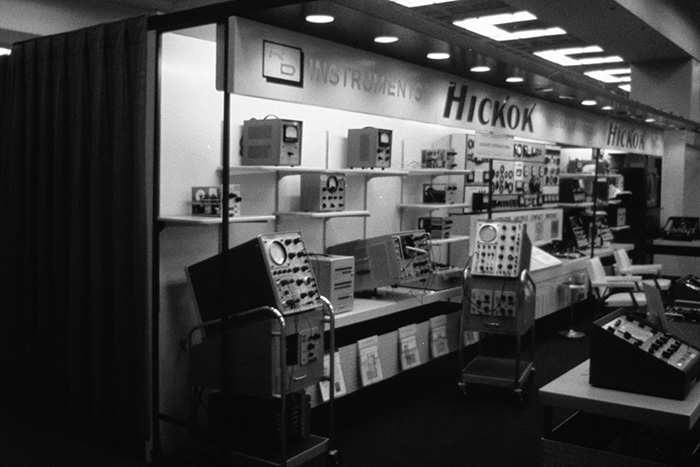 Feb 2025 POM: Hickok trade show booth with clone scopes
Feb 2025 POM: Hickok trade show booth with clone scopes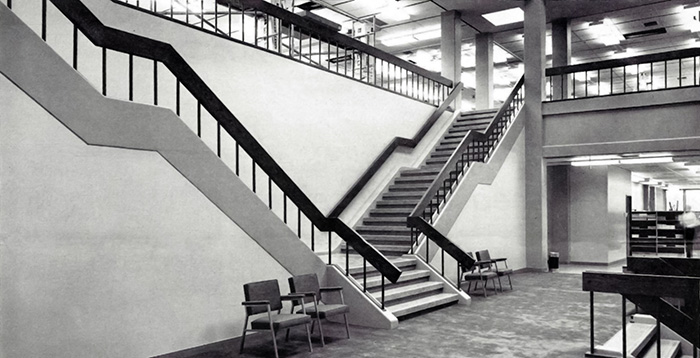 Mar 2025 POM: Building 50 Technical Center grand stairway
Mar 2025 POM: Building 50 Technical Center grand stairway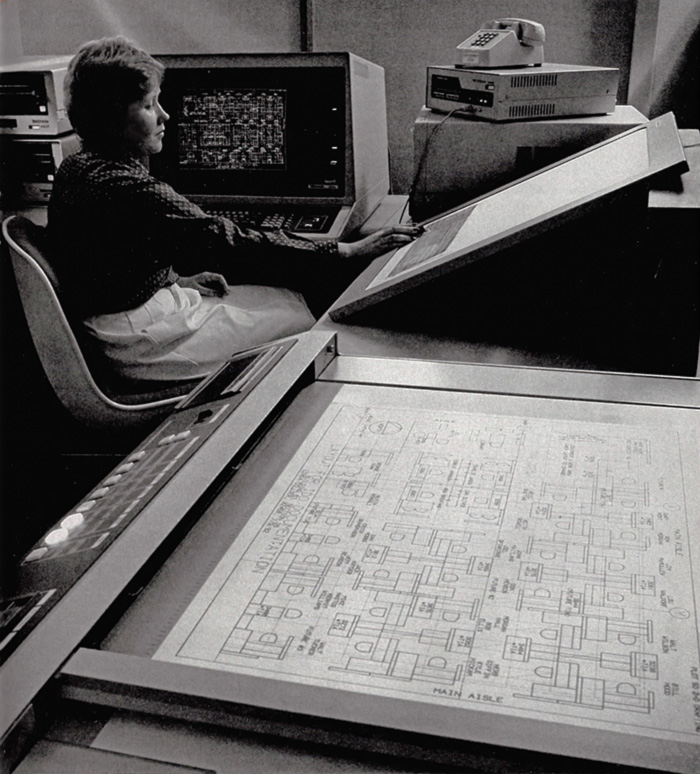 Apr 2025 POM: A woman using a suite of IDD CAD products.
Apr 2025 POM: A woman using a suite of IDD CAD products.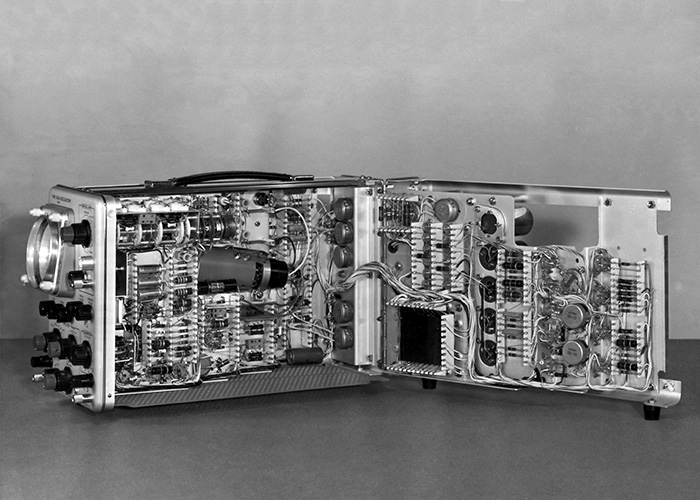 May 2025 POM: The 310A's remarkable high density design.
May 2025 POM: The 310A's remarkable high density design.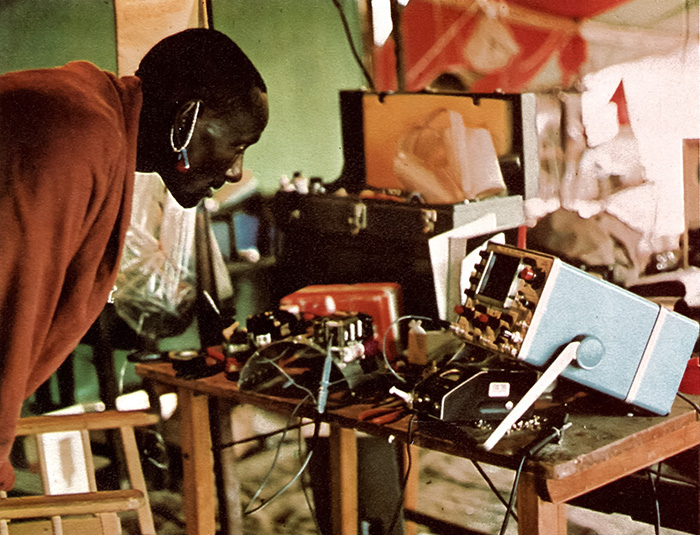 June 2025 POM: A Masai warrior's curious look at the 422 oscilloscope in Kenya.
June 2025 POM: A Masai warrior's curious look at the 422 oscilloscope in Kenya.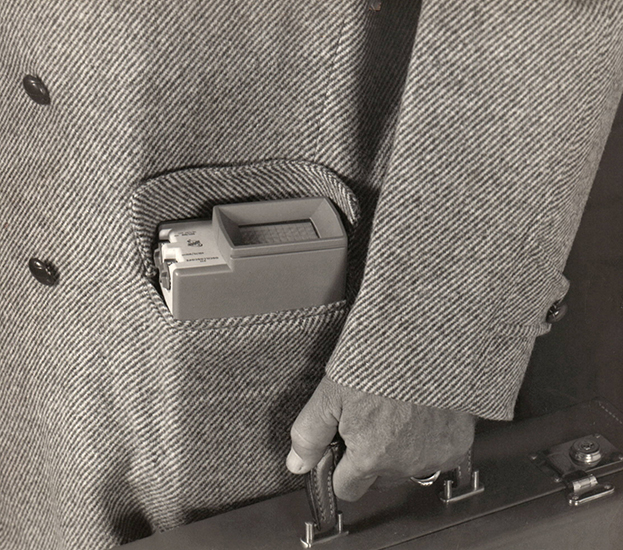 July 2025 POM: Photo from the 211 miniscope ad.
July 2025 POM: Photo from the 211 miniscope ad.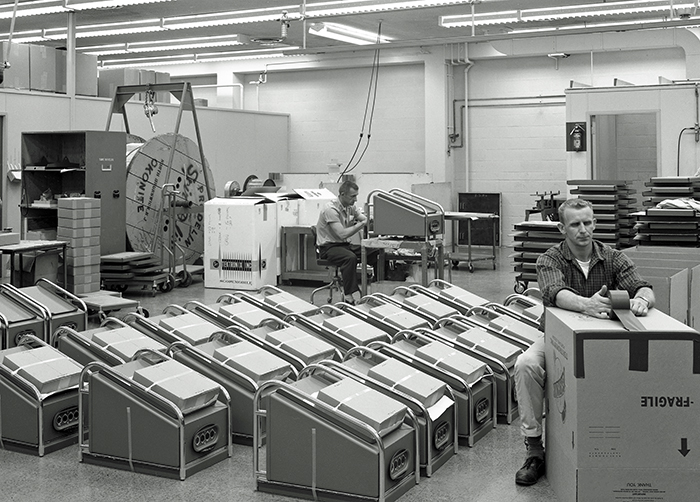 August 2025 POM:R-500 Scope-Mobiles and Spir-o-line.
August 2025 POM:R-500 Scope-Mobiles and Spir-o-line.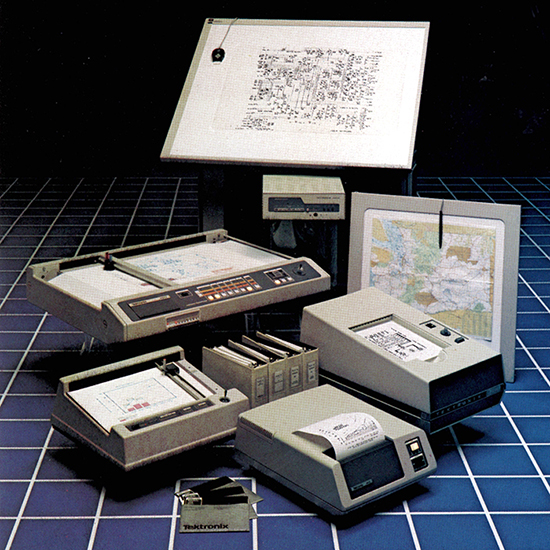 Sept 2025 POM: IDG hard copy related products
Sept 2025 POM: IDG hard copy related products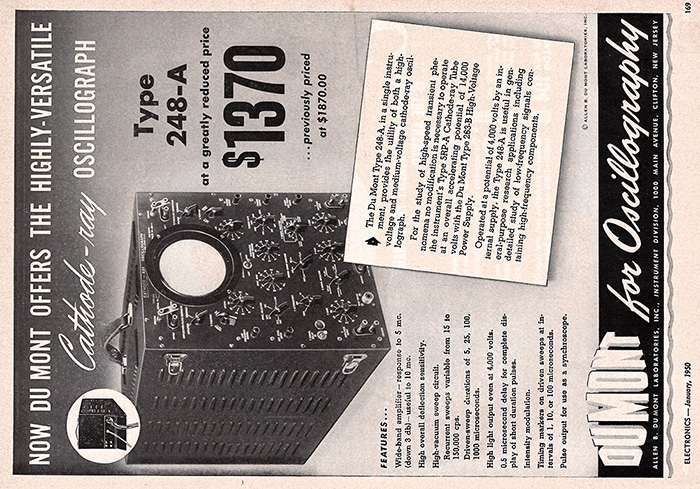 Oct 2025 POM: An ad for the DuMont 248, primary competitor to the 511
Oct 2025 POM: An ad for the DuMont 248, primary competitor to the 511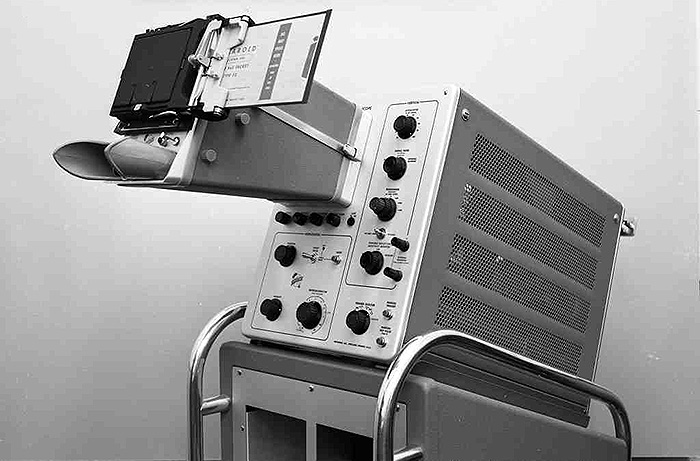 Nov 2025 POM: Type 507 oscilloscope with unique camera
Nov 2025 POM: Type 507 oscilloscope with unique camera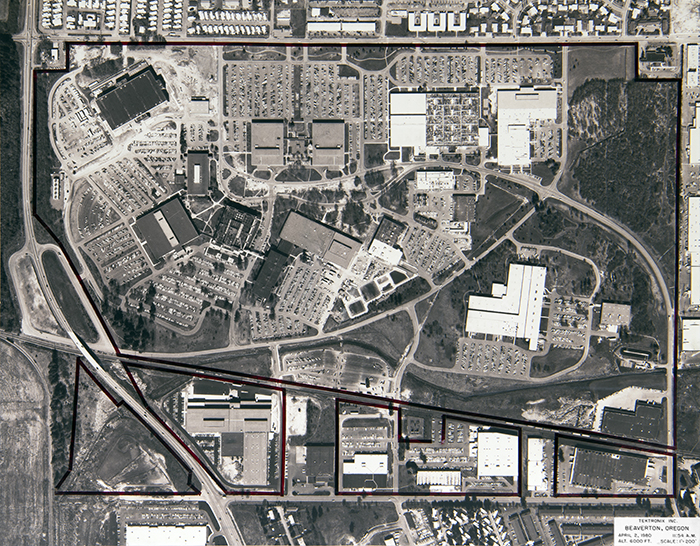 Dec 2025 POM: High aerial view BV campusApril 2, 1980
Dec 2025 POM: High aerial view BV campusApril 2, 1980
Photos of the Month: Feb 2019 - Dec 2024
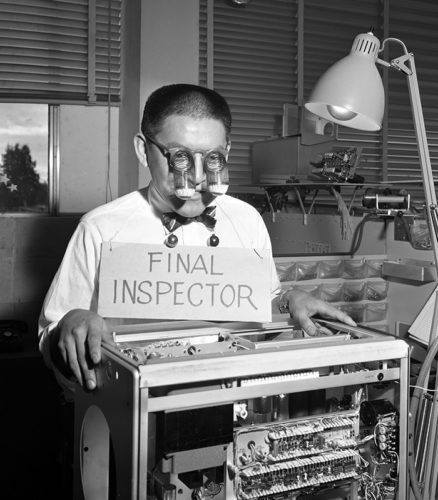 Feb 2019 PoM - Clyde Faber, actual final inspector, poses for February 1957 TekTalk article
Feb 2019 PoM - Clyde Faber, actual final inspector, poses for February 1957 TekTalk article Mar 2019 PoM - Processing selenium rectifiers at the Sunset Plant in 1957
Mar 2019 PoM - Processing selenium rectifiers at the Sunset Plant in 1957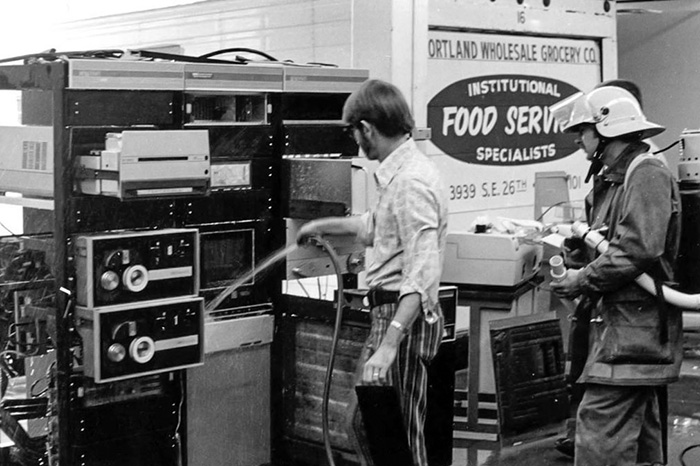 Apr 2019 PoM - Jim Geddes washing a DEC minicomputer after a water leak dissolved the ceiling tiles - and it worked!
Apr 2019 PoM - Jim Geddes washing a DEC minicomputer after a water leak dissolved the ceiling tiles - and it worked!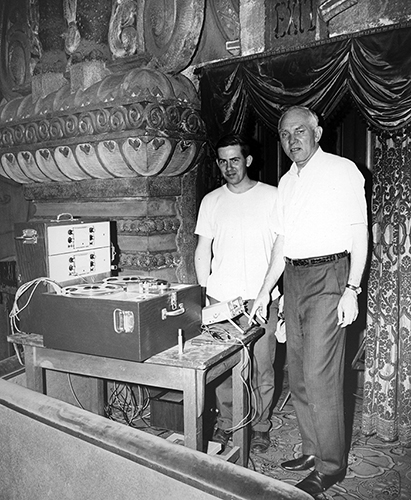 May 2019 PoM - Howard Vollum & Dennis Hedberg at Oriental Theater with Dynatrack 3M tape recorder in 1969. Photo by Rodgers Jenkins.
May 2019 PoM - Howard Vollum & Dennis Hedberg at Oriental Theater with Dynatrack 3M tape recorder in 1969. Photo by Rodgers Jenkins.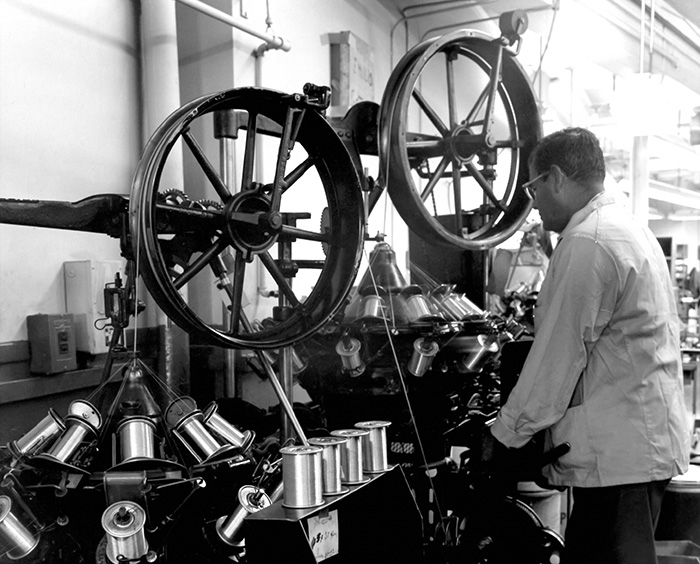 June 2019 PoM - Cable Operations flexible coax shield winding machine. These were repurposed shoelace weavers from the turn of the century.
June 2019 PoM - Cable Operations flexible coax shield winding machine. These were repurposed shoelace weavers from the turn of the century. July 2019 PoM: Construction of the new Technical Center building 50 from the 1964 Annual Report
July 2019 PoM: Construction of the new Technical Center building 50 from the 1964 Annual Report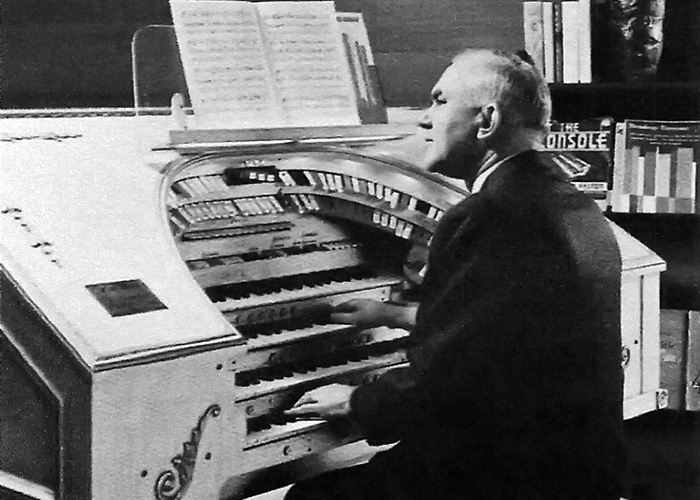 Aug 2019 POM: Howard Vollum at his home organ
Aug 2019 POM: Howard Vollum at his home organ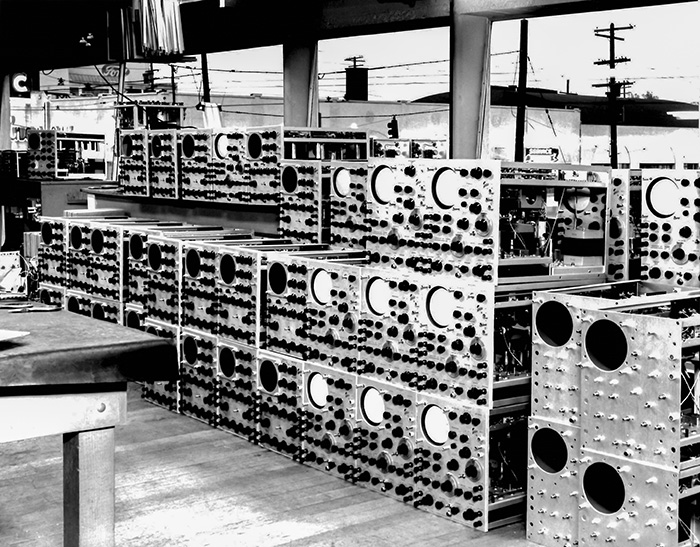 Sept 2019 POM: 511 and 512 oscilloscopes in process at the Hawthorne plant circa 1949
Sept 2019 POM: 511 and 512 oscilloscopes in process at the Hawthorne plant circa 1949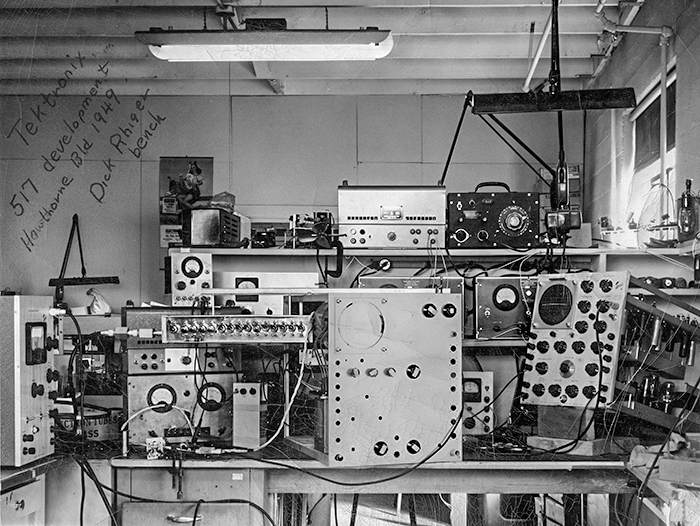 Oct 2019 POM: Dick Rhiger bench at Hawthorne for the 517 Development
Oct 2019 POM: Dick Rhiger bench at Hawthorne for the 517 Development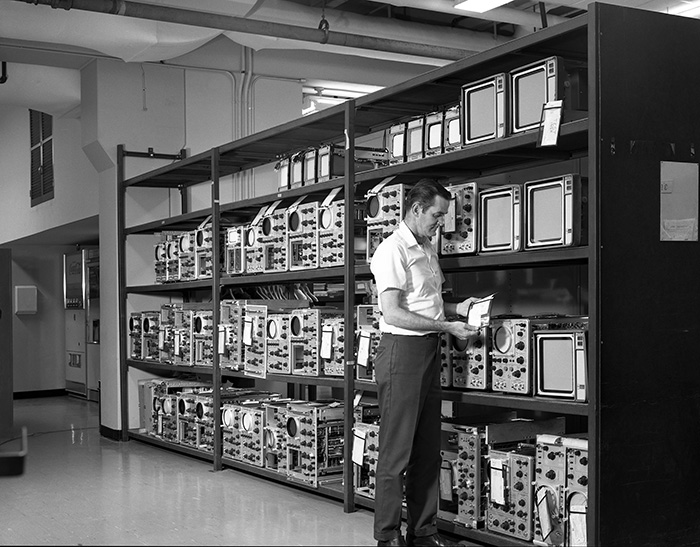 Nov 2019 POM: Building 39 Assembly East first floor shipping dock (at the building south end) in ~1968
Nov 2019 POM: Building 39 Assembly East first floor shipping dock (at the building south end) in ~1968 Dec 2019 POM: 2200 Series Oscilloscope high volume line
Dec 2019 POM: 2200 Series Oscilloscope high volume line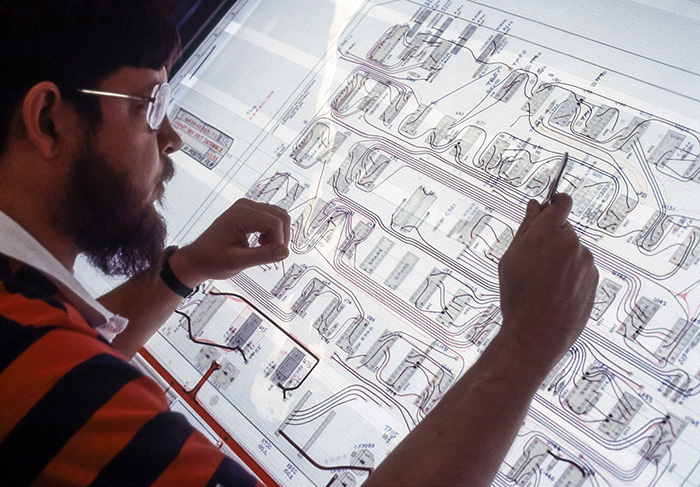 Jan 2020 POM: Hand-taped PCB layout
Jan 2020 POM: Hand-taped PCB layout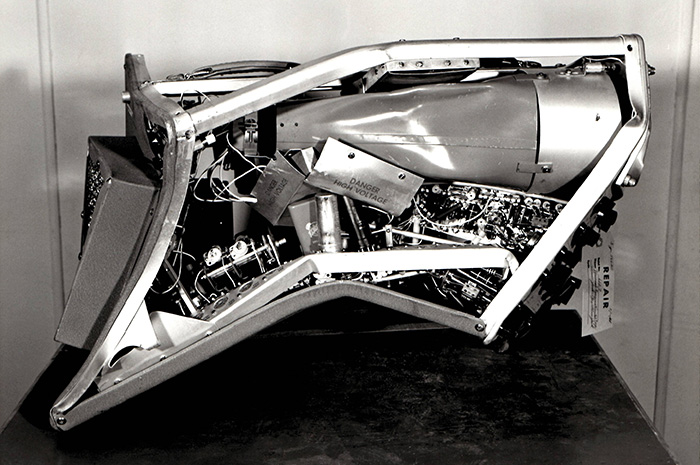 Feb 2020 POM: 524AD oscilloscope sent in for repairs
Feb 2020 POM: 524AD oscilloscope sent in for repairs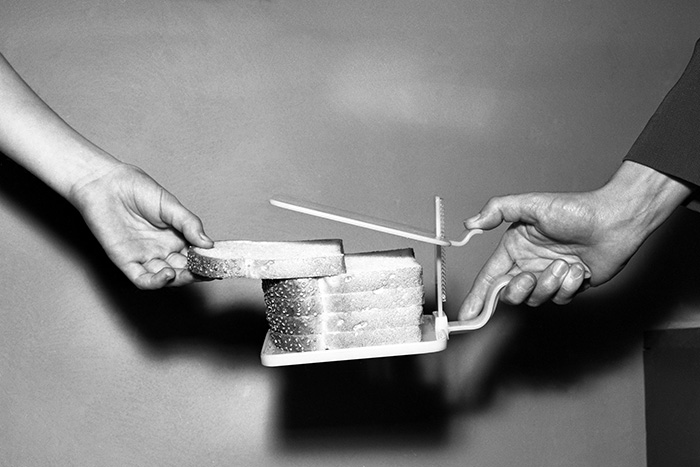 Mar 2020 POM: Used in Tek lunchrooms to keep the bread fresh
Mar 2020 POM: Used in Tek lunchrooms to keep the bread fresh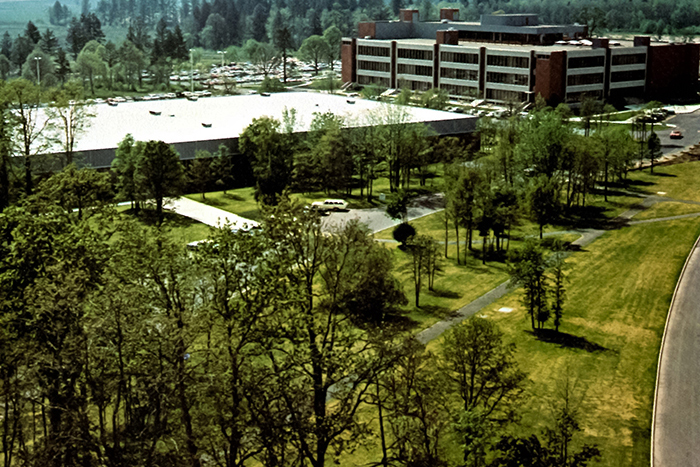 Apr 2020 POM: Tek received an award for beautification of Oregon from Governor Hatfield. Fall 1966 TekTalk.
Apr 2020 POM: Tek received an award for beautification of Oregon from Governor Hatfield. Fall 1966 TekTalk.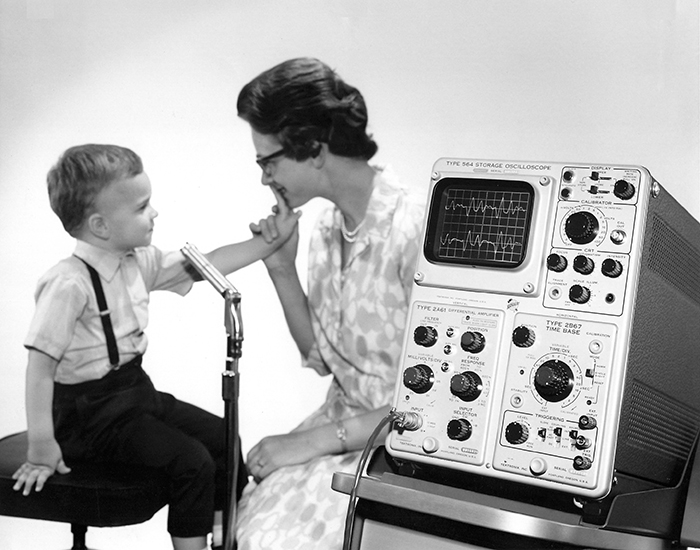 May 2020 POM: John receiving speech therapy at Portland's Tucker-Mason Oral School.
May 2020 POM: John receiving speech therapy at Portland's Tucker-Mason Oral School.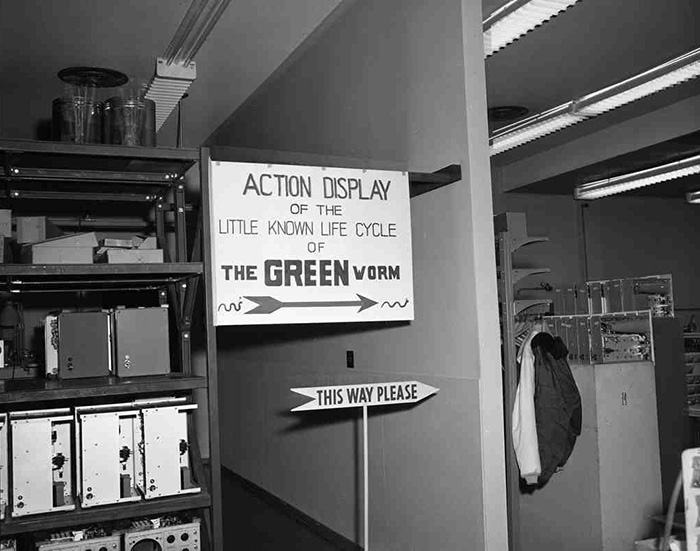 June 2020 POM: Family Night at Plant 2
June 2020 POM: Family Night at Plant 2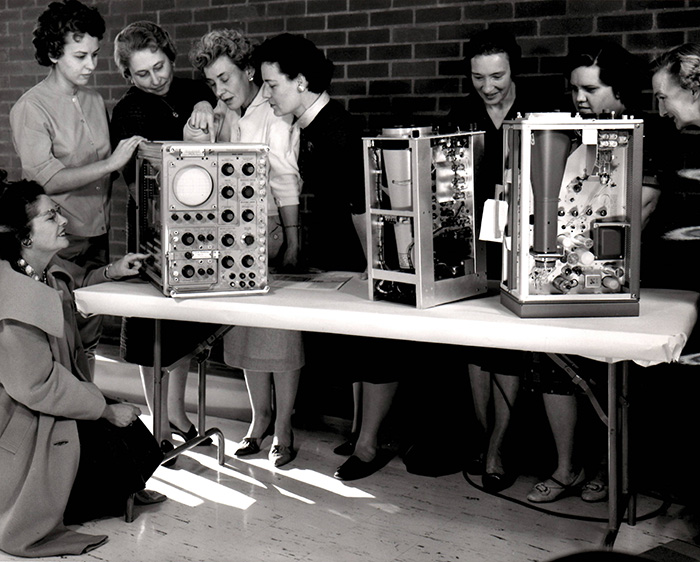 July 2020 POM: Women pointing at a 945 Militarized Oscilloscope. We have no clue.
July 2020 POM: Women pointing at a 945 Militarized Oscilloscope. We have no clue.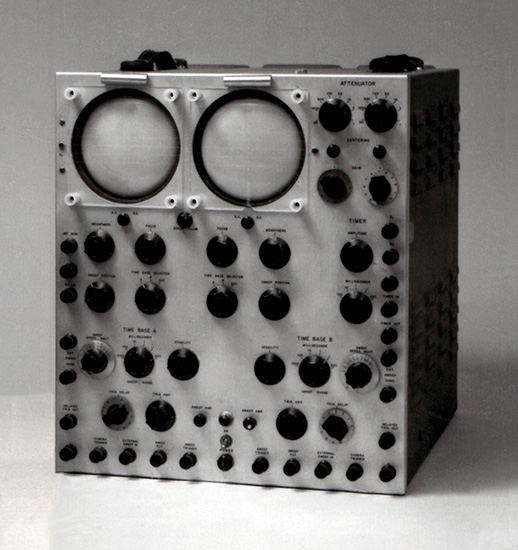 Aug 2020 POM: Mysterious vintage dual CRT instrument. We have no idea.
Aug 2020 POM: Mysterious vintage dual CRT instrument. We have no idea.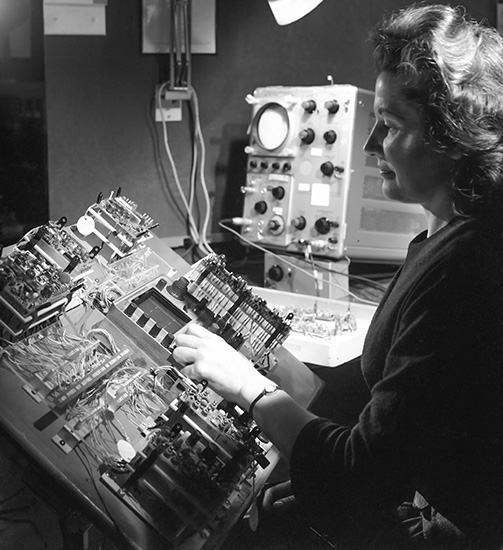 Sept 2020 POM: Employee performing a 422 portable oscilloscope exploded board test.
Sept 2020 POM: Employee performing a 422 portable oscilloscope exploded board test.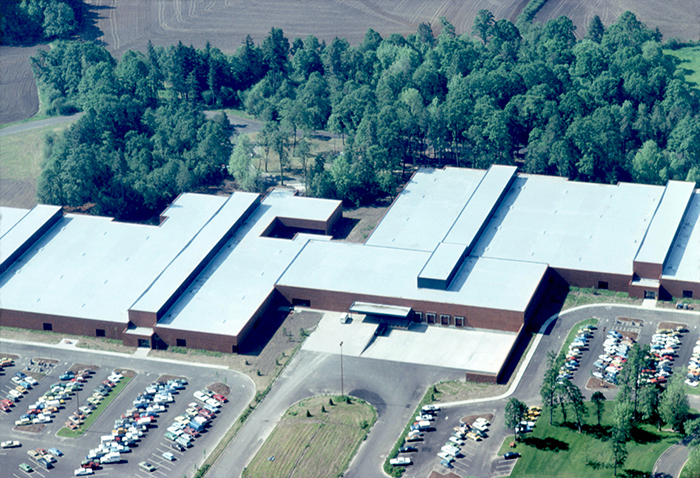 Oct 2020 POM: Wilsonville Bldg 60 prior to the addition of the EMI and Safety lab, ~ late 1970s.
Oct 2020 POM: Wilsonville Bldg 60 prior to the addition of the EMI and Safety lab, ~ late 1970s.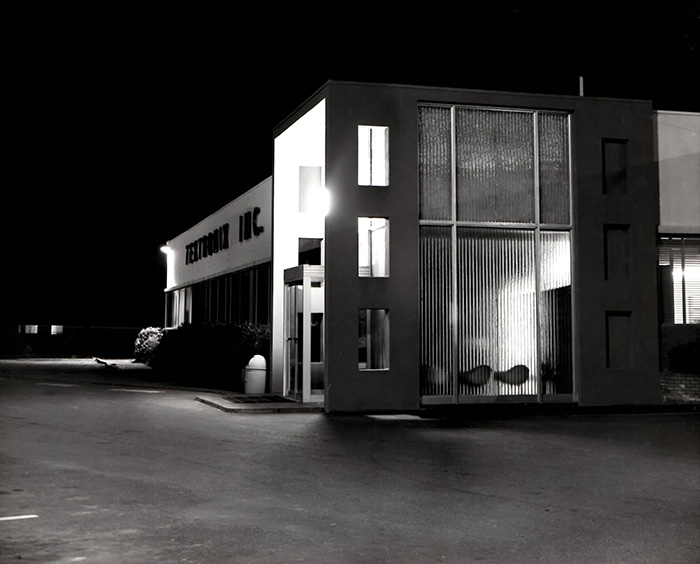 Nov 2020 POM: Night photo of the entrance to the Sunset plant.
Nov 2020 POM: Night photo of the entrance to the Sunset plant.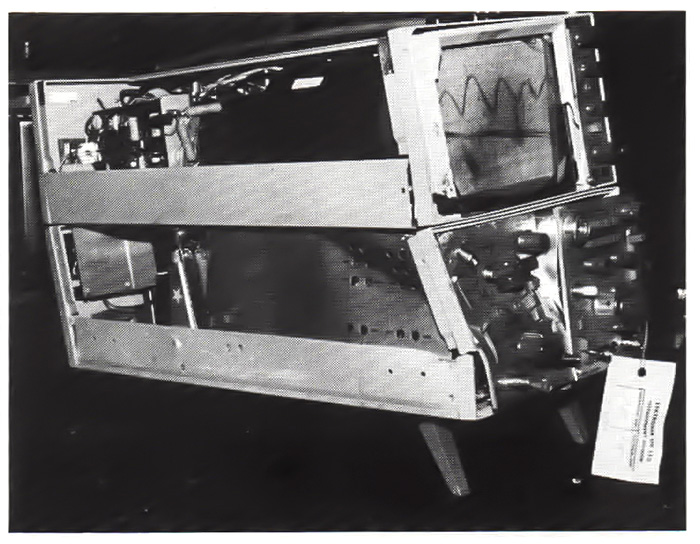 Dec 2020 POM: Telequipment D83 oscilloscope sent in for repairs.
Dec 2020 POM: Telequipment D83 oscilloscope sent in for repairs.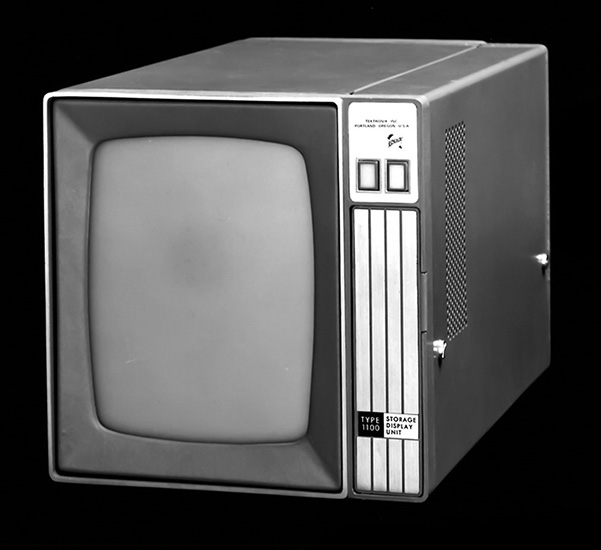 Jan 2021 POM: Type 1100 Storage Display Unit. We do not know if this ever was produced.
Jan 2021 POM: Type 1100 Storage Display Unit. We do not know if this ever was produced.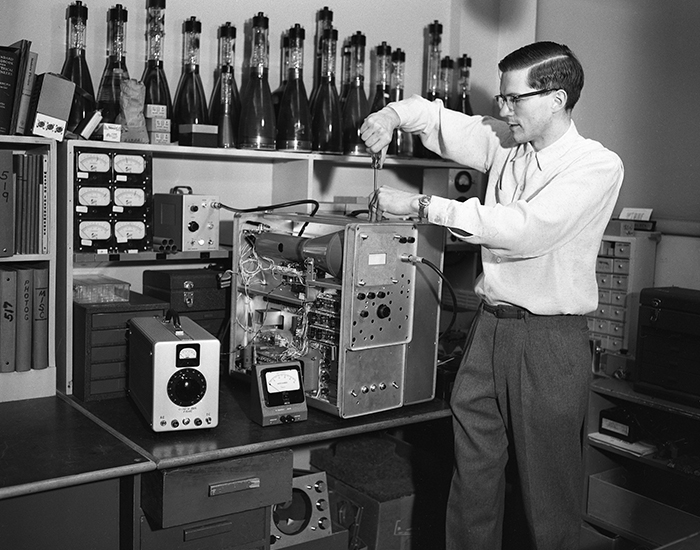 Feb 2021 POM: Cliff Moulton working on a prototype of the 519 1 GHz oscilloscope.
Feb 2021 POM: Cliff Moulton working on a prototype of the 519 1 GHz oscilloscope.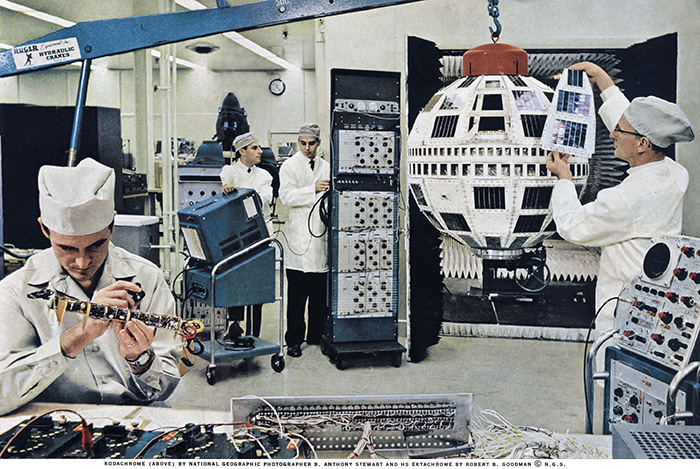 Mar 2021 POM: Telstar development showing 26 Tektronix Instruments - May 1962 National Geographic Magazine
Mar 2021 POM: Telstar development showing 26 Tektronix Instruments - May 1962 National Geographic Magazine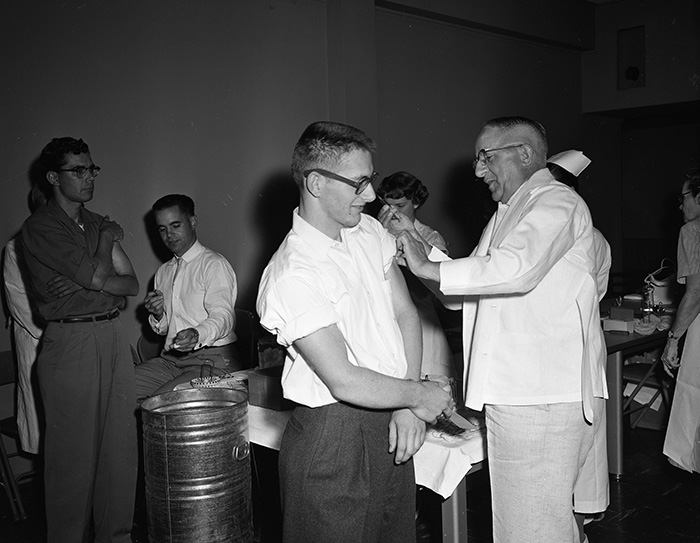 April 2021 POM: Vaccinations at Tektronix, likely polio in late 1950s
April 2021 POM: Vaccinations at Tektronix, likely polio in late 1950s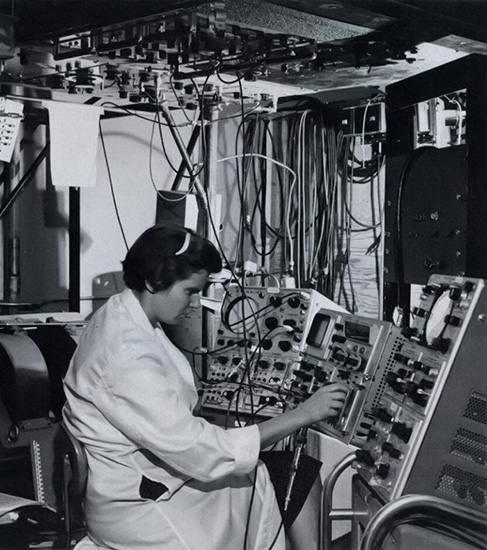 May 2021 POM: Plasma physics research with a 551 and 555 dual beam oscilloscope and a RM567 sampling oscilloscope
May 2021 POM: Plasma physics research with a 551 and 555 dual beam oscilloscope and a RM567 sampling oscilloscope June 2021 POM: Wide-angle photo of Beaverton campus circa 1964 from Jenkins Road
June 2021 POM: Wide-angle photo of Beaverton campus circa 1964 from Jenkins Road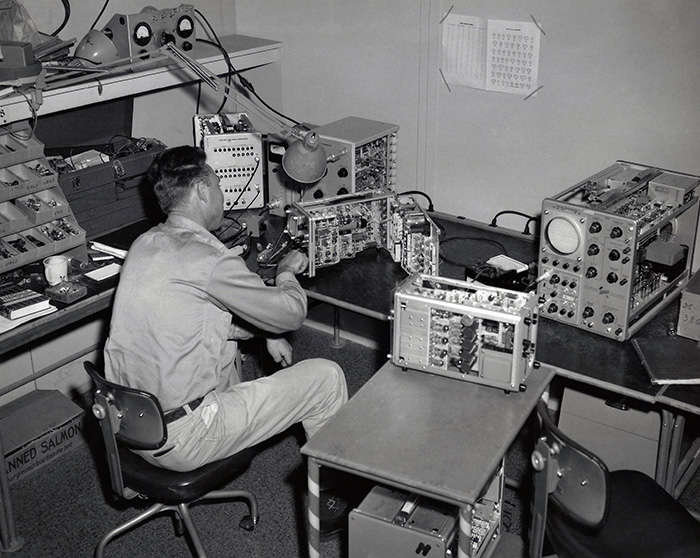 July 2021 POM: Eugene Wilson in Test working on a 310
July 2021 POM: Eugene Wilson in Test working on a 310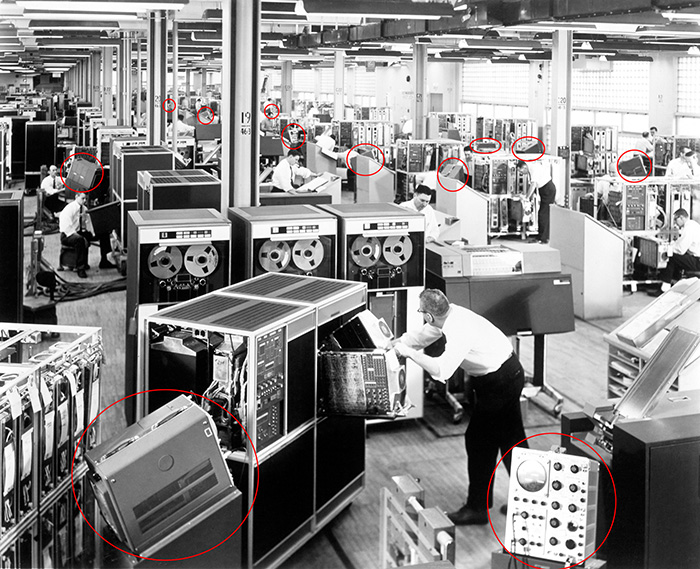 August 2021 POM: Manufacturing floor of IBM 1401 computer showing numerous Tektronix oscilloscopes
August 2021 POM: Manufacturing floor of IBM 1401 computer showing numerous Tektronix oscilloscopes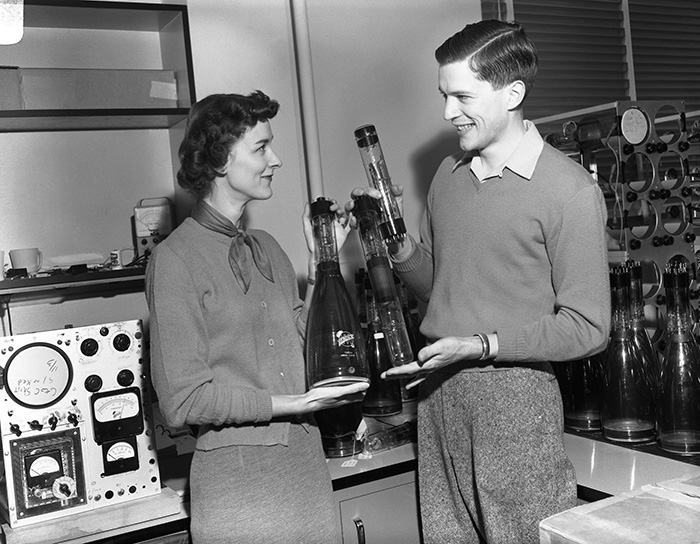 Sept 2021 POM: MariLe and Cliff Moulton, 1954
Sept 2021 POM: MariLe and Cliff Moulton, 1954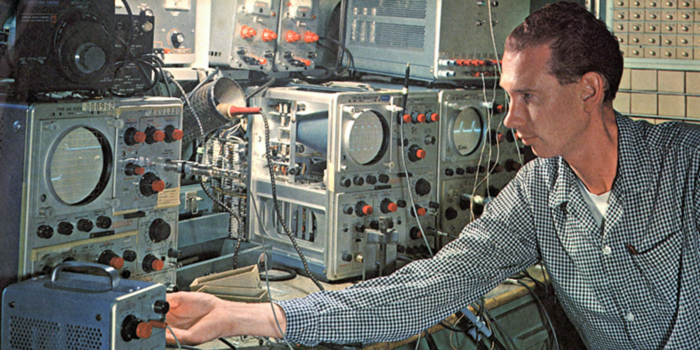 Oct 2021 POM: George Frye testing new design circuits. Photo from the February 1964 Tekalendar
Oct 2021 POM: George Frye testing new design circuits. Photo from the February 1964 Tekalendar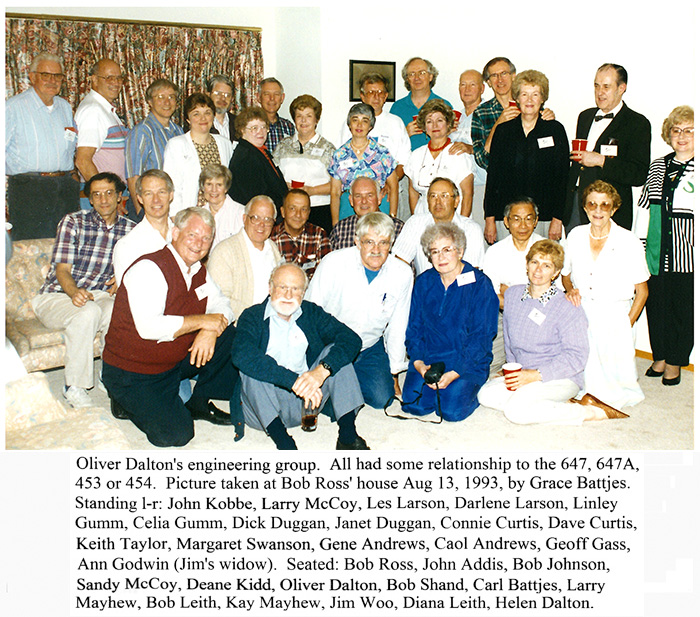 Nov 2021 POM: 1993 reunion photo of Oliver Dalton's engineering group
Nov 2021 POM: 1993 reunion photo of Oliver Dalton's engineering group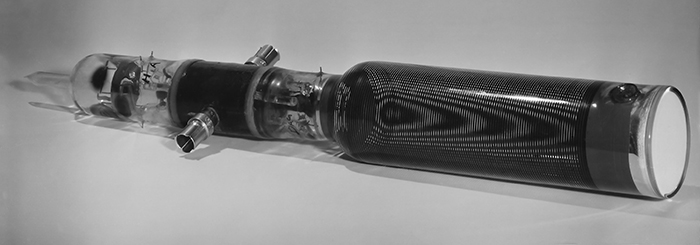 Dec 2021 POM: Prototype T519 CRT with preliminary vertical deflection connectors
Dec 2021 POM: Prototype T519 CRT with preliminary vertical deflection connectors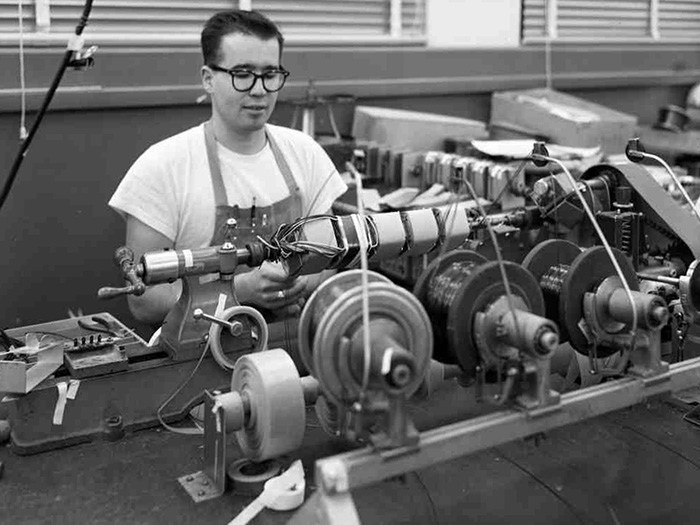 Jan 2022 POM: Bob Cogan winding transformers
Jan 2022 POM: Bob Cogan winding transformers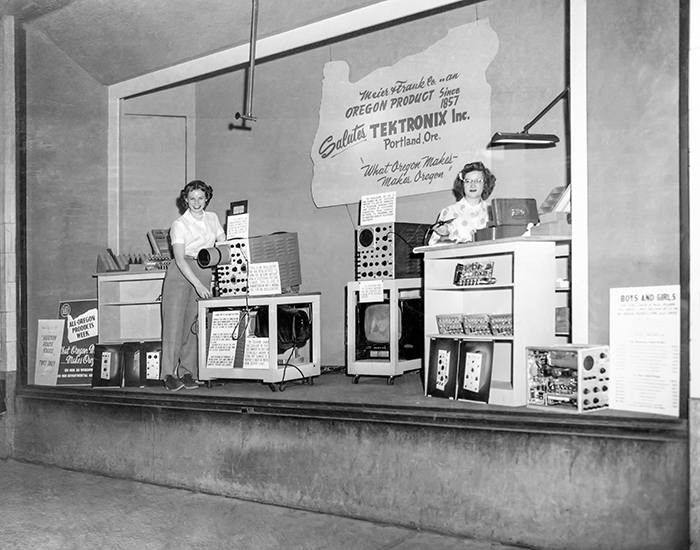 Feb 2022 POM: Tektronix products featured in Meier & Frank storefront window April 1951
Feb 2022 POM: Tektronix products featured in Meier & Frank storefront window April 1951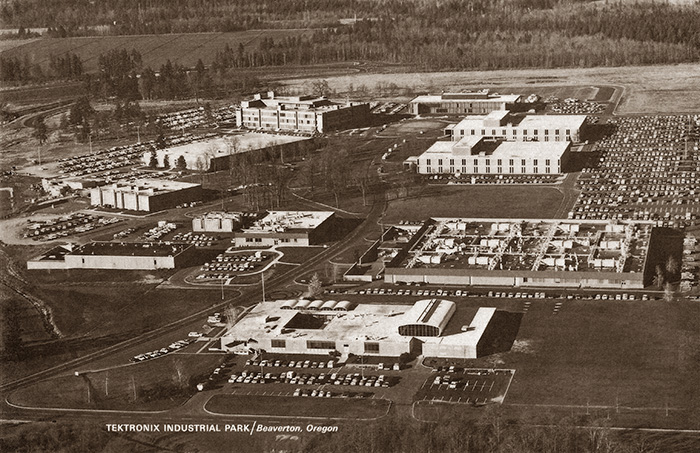 Mar 2022 POM: Placemat of the Tektronix campus probably late 1966 to early 1967
Mar 2022 POM: Placemat of the Tektronix campus probably late 1966 to early 1967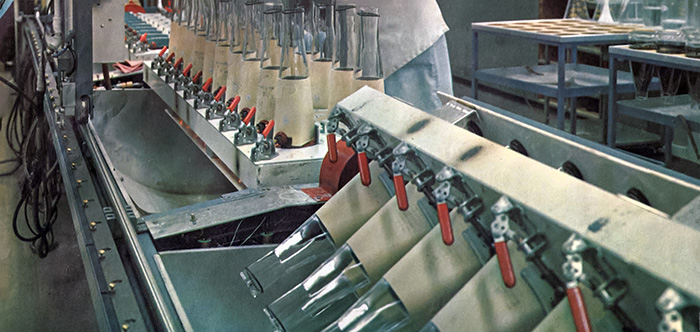 Apr 2022 POM: Decanting CRT funnels from the August 1964 Tekalendar
Apr 2022 POM: Decanting CRT funnels from the August 1964 Tekalendar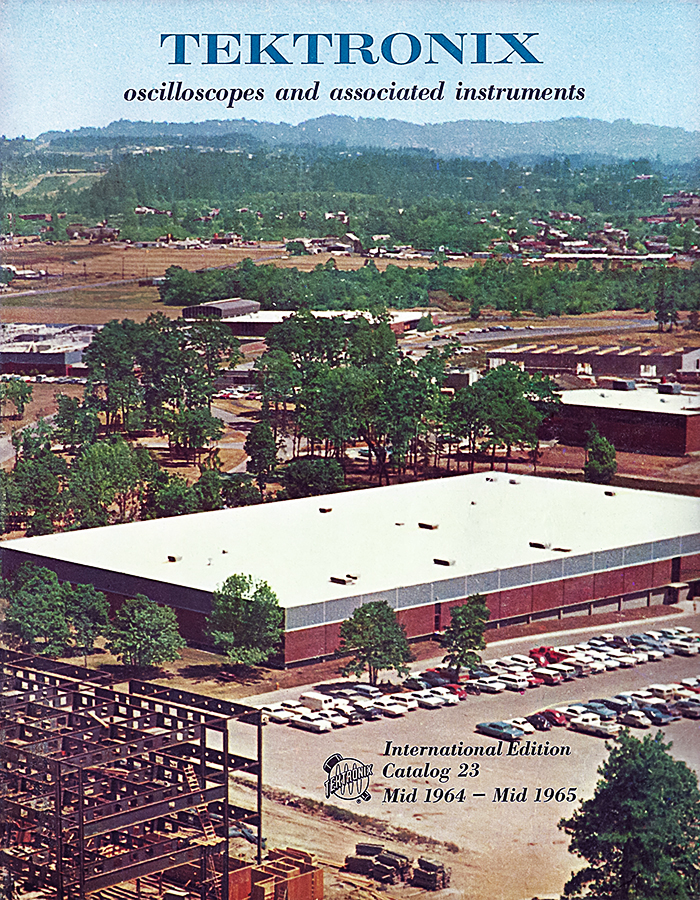 May 2022 POM: Beaverton campus from the mid-1964 - mid 1965 Tektronix catalog
May 2022 POM: Beaverton campus from the mid-1964 - mid 1965 Tektronix catalog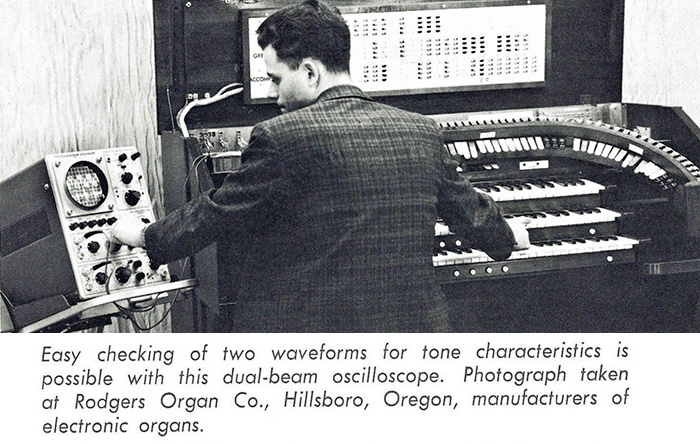 June 2022 POM: 502A dual beam oscilloscope used at Rodgers Organ
June 2022 POM: 502A dual beam oscilloscope used at Rodgers Organ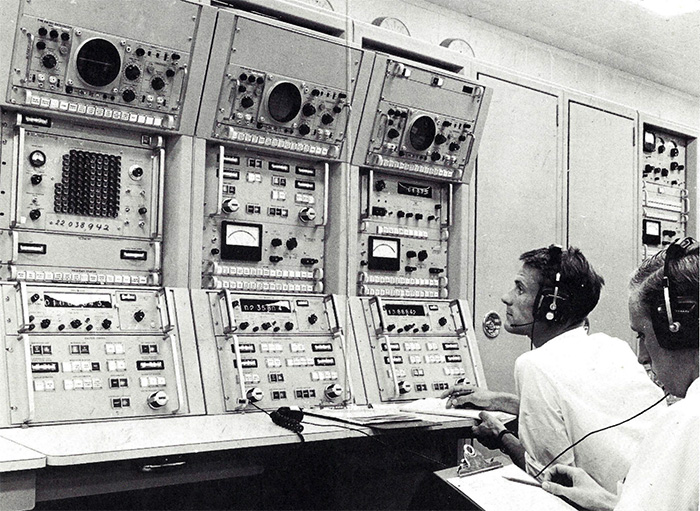 July 2022 POM: Tektronix oscilloscopes used at the Tidbinbilla Deep Space Tracking station in Australia
July 2022 POM: Tektronix oscilloscopes used at the Tidbinbilla Deep Space Tracking station in Australia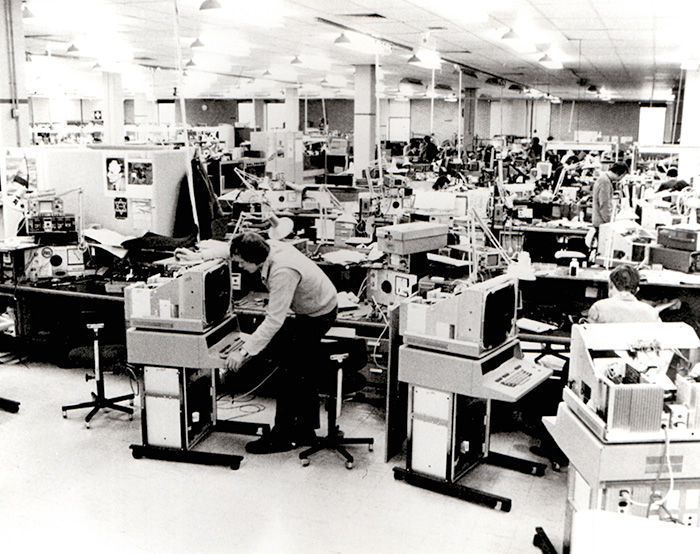 August 2022 POM: 4114 Computer Display Terminal production in Heerenveen
August 2022 POM: 4114 Computer Display Terminal production in Heerenveen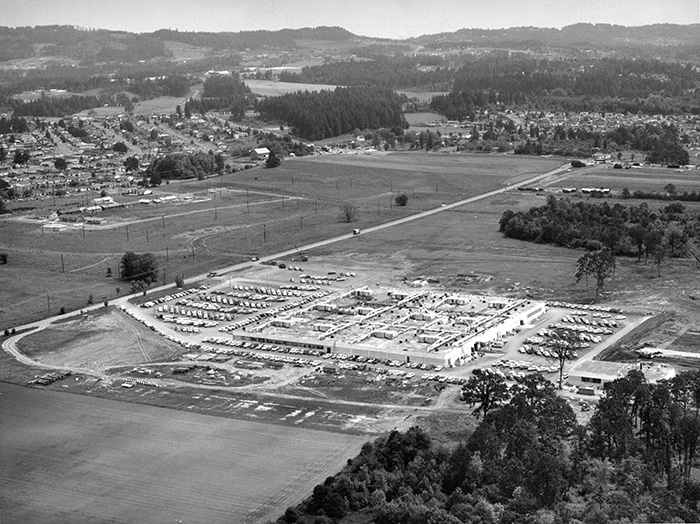 September 2022 POM: Building 19 under construction in 1958 looking NE
September 2022 POM: Building 19 under construction in 1958 looking NE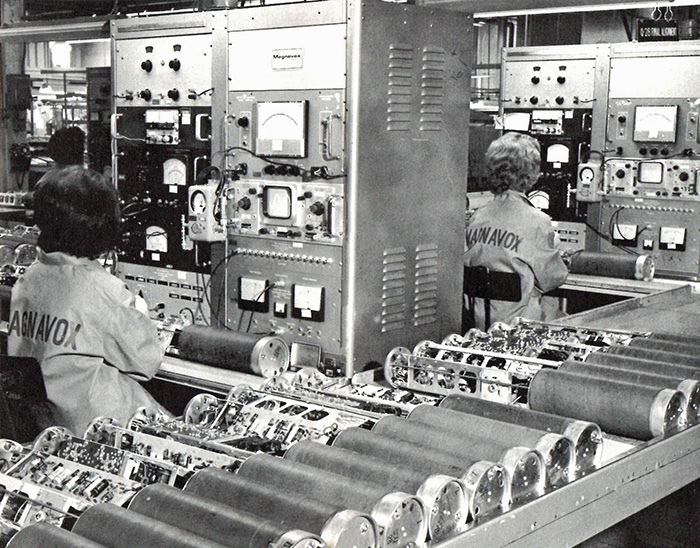 October 2022 POM: Magnavox production line featuring RM561A oscilloscopes with 3A75 and 2B67 plug-ins
October 2022 POM: Magnavox production line featuring RM561A oscilloscopes with 3A75 and 2B67 plug-ins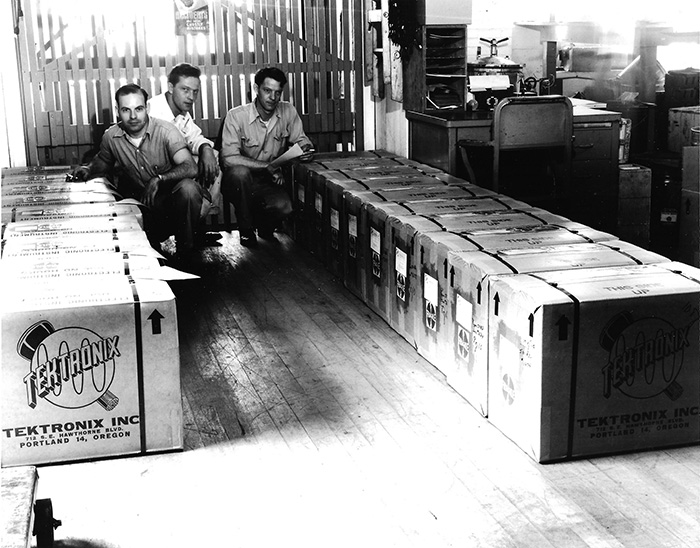 November 2022 POM: A large order of Type 511AD Oscilloscopes from the Hawthorne plant 1950
November 2022 POM: A large order of Type 511AD Oscilloscopes from the Hawthorne plant 1950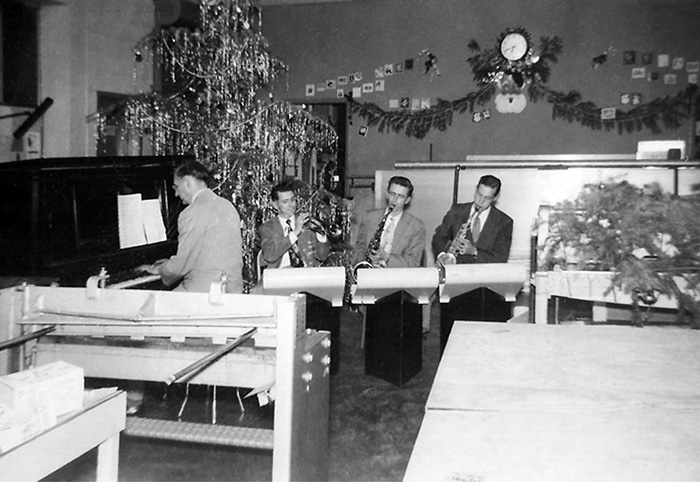 December 2022 POM: 1951 Christmas Party. Tektronix Band members Vern Bartlett, Jack Neff, Doug Prouty, and Jack Gaeth.
December 2022 POM: 1951 Christmas Party. Tektronix Band members Vern Bartlett, Jack Neff, Doug Prouty, and Jack Gaeth.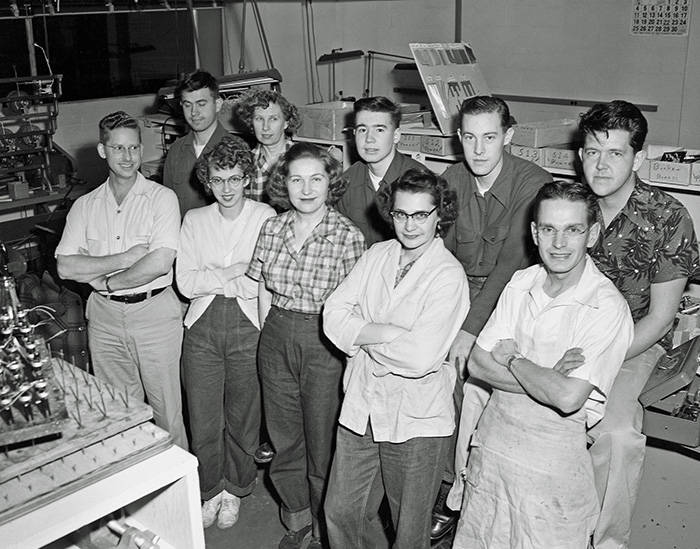 January 2023 POM: Swing shift transformer employees 1951
January 2023 POM: Swing shift transformer employees 1951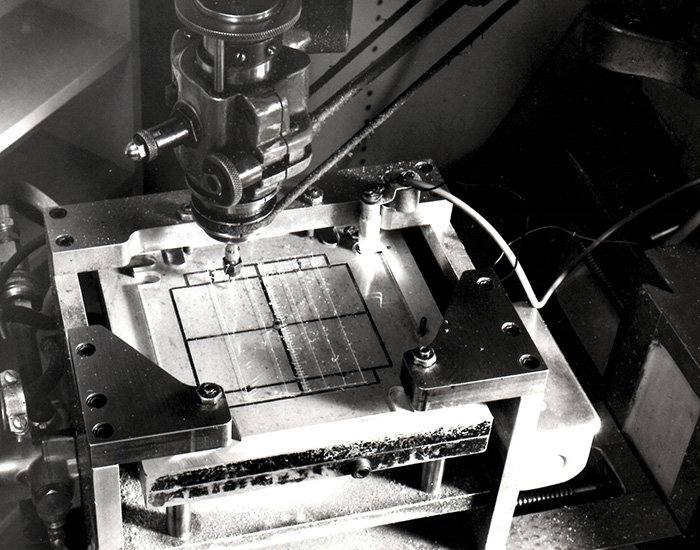 February 2023 POM: Scribing the lines on an external CRT graticule.
February 2023 POM: Scribing the lines on an external CRT graticule.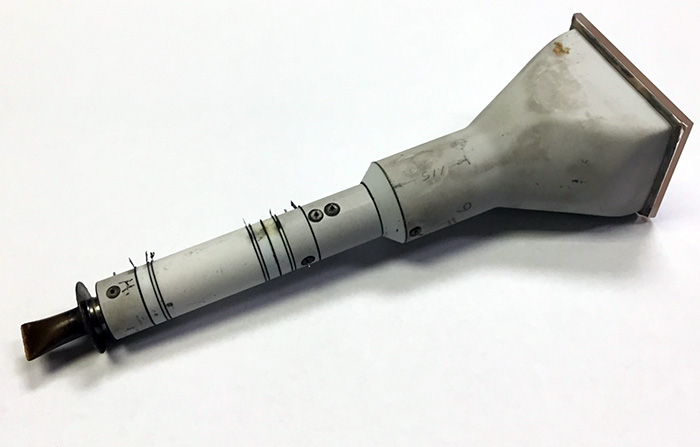 March 2023 POM: All ceramic concept CRT.
March 2023 POM: All ceramic concept CRT.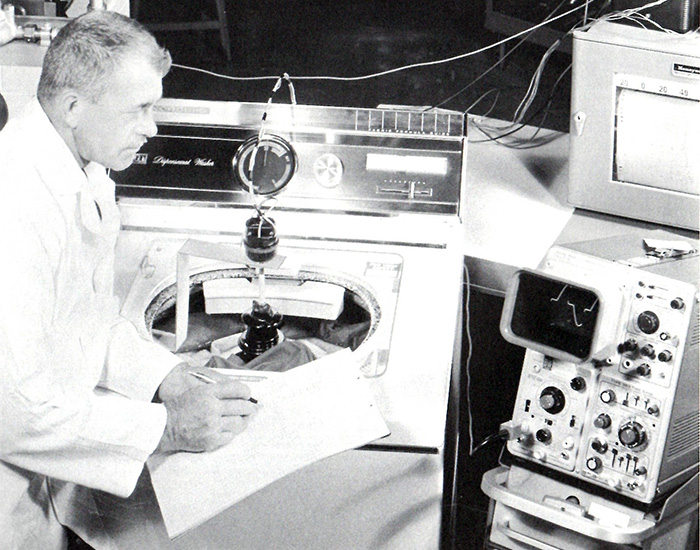 April 2023 POM: 564 used in washing machine testing. Photo courtesy of Industrial Electronics magazine, BBC, and Borg-Warner
April 2023 POM: 564 used in washing machine testing. Photo courtesy of Industrial Electronics magazine, BBC, and Borg-Warner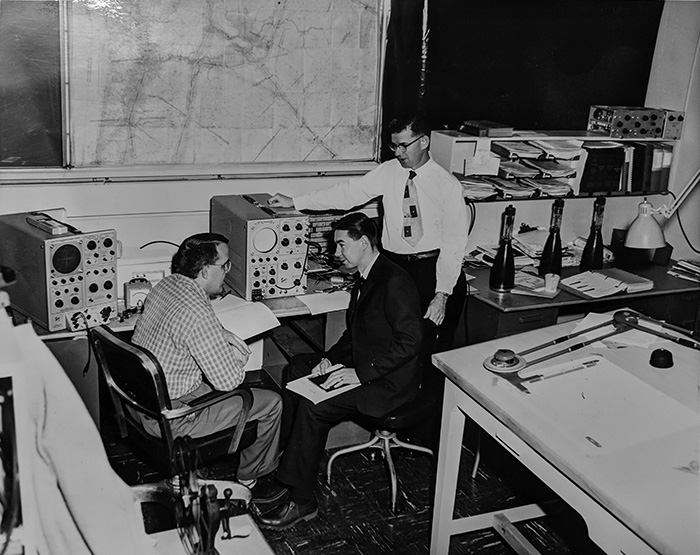 May 2023 POM: Tektronix engineering circa 1959. Deane Kidd is on the left.
May 2023 POM: Tektronix engineering circa 1959. Deane Kidd is on the left.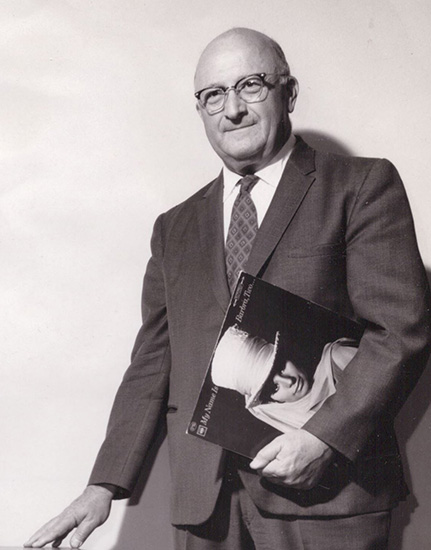 June 2023 POM: The only photo we have of Tektronix co-founder Glenn McDowell
June 2023 POM: The only photo we have of Tektronix co-founder Glenn McDowell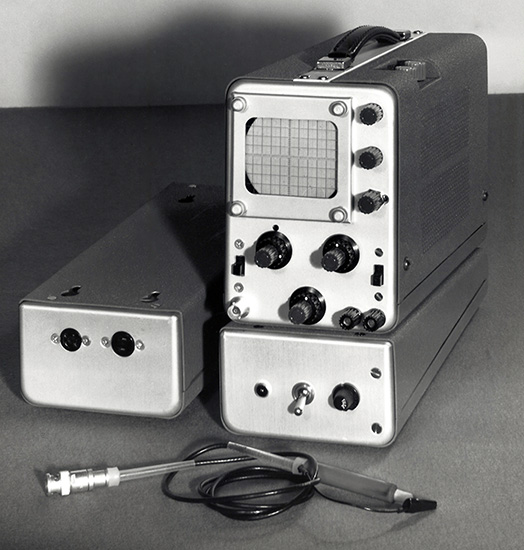 July 2023 POM: Undated photograph of an unknown portable, possibly a concept for the 321.
July 2023 POM: Undated photograph of an unknown portable, possibly a concept for the 321.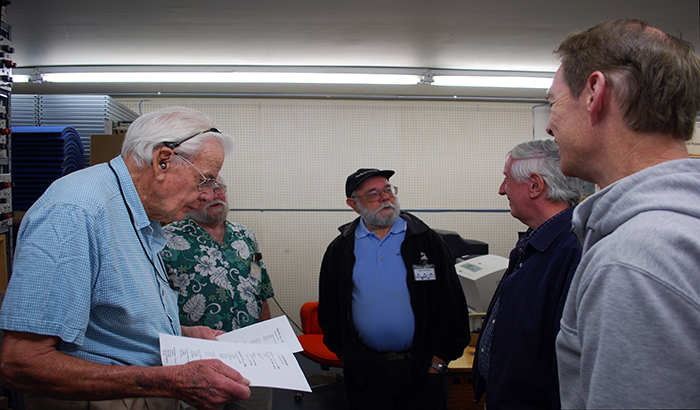 August 2023 POM: John Kobbe, Phil Crosby, Stan Griffiths, John Gates & John Addis on Oct 21, 2011
August 2023 POM: John Kobbe, Phil Crosby, Stan Griffiths, John Gates & John Addis on Oct 21, 2011 Sept 2023 POM: Promotional photo of 485 350 MHz portable oscilloscope.
Sept 2023 POM: Promotional photo of 485 350 MHz portable oscilloscope.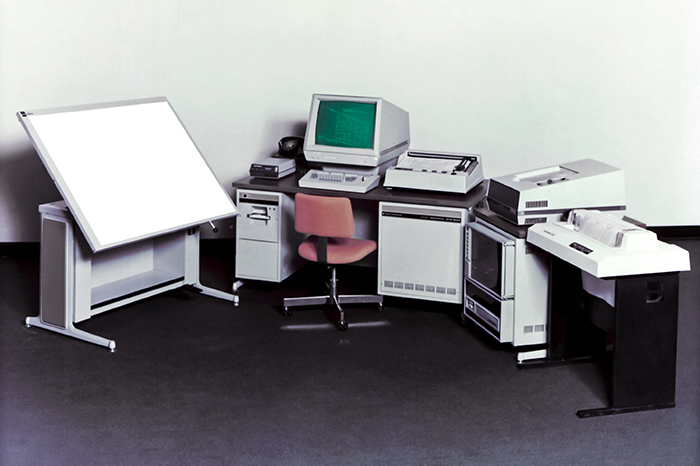 Oct 2023 POM: graphic work system comprised of Tablet, modem, 4081, 4662, 4631,, and 4641.
Oct 2023 POM: graphic work system comprised of Tablet, modem, 4081, 4662, 4631,, and 4641.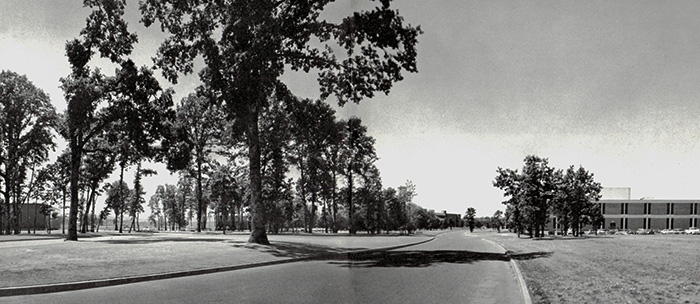 Nov 2023 POM: campus photo from 1965 Annual Report looking west from Karl Braun Dr. Buildings are 38 Electrochem & 46 CRT on left, 47 Assembly on right, and 50 Technical Center in middle.
Nov 2023 POM: campus photo from 1965 Annual Report looking west from Karl Braun Dr. Buildings are 38 Electrochem & 46 CRT on left, 47 Assembly on right, and 50 Technical Center in middle.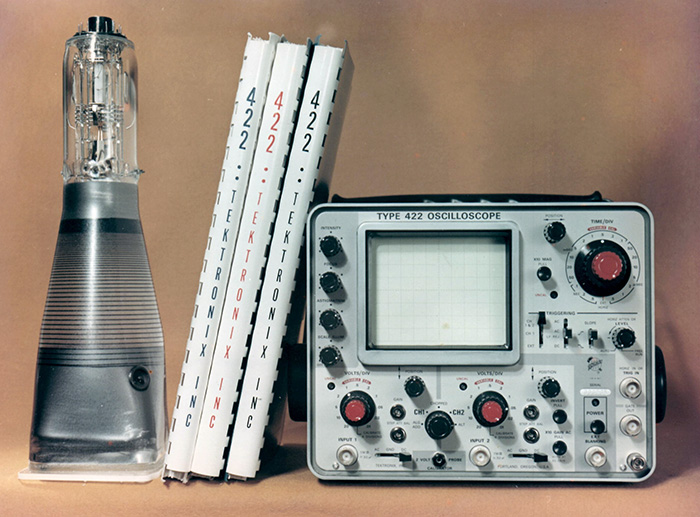 Dec 2023 POM: 422 oscilloscope, manuals, and CRT.
Dec 2023 POM: 422 oscilloscope, manuals, and CRT.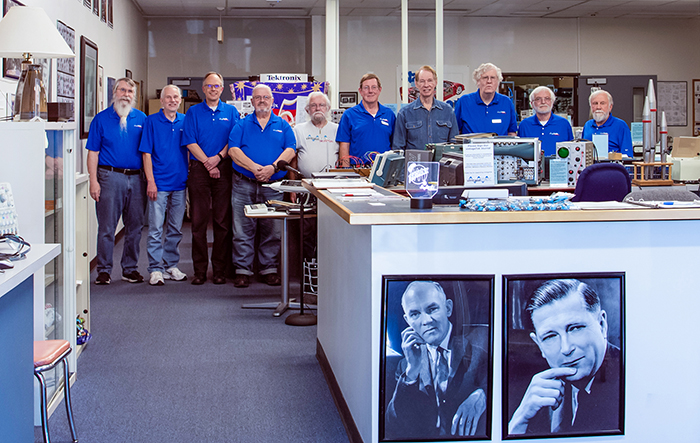 Jan 2024 POM: Museum volunteers (l to r) Dave Brown, Ron Fairley, Andrew Meier, Lorren Fletcher, Phil Crosby, Gary Johnson, John Addis, Bob Haas, Kurt Krueger, and Pat Green.
Jan 2024 POM: Museum volunteers (l to r) Dave Brown, Ron Fairley, Andrew Meier, Lorren Fletcher, Phil Crosby, Gary Johnson, John Addis, Bob Haas, Kurt Krueger, and Pat Green.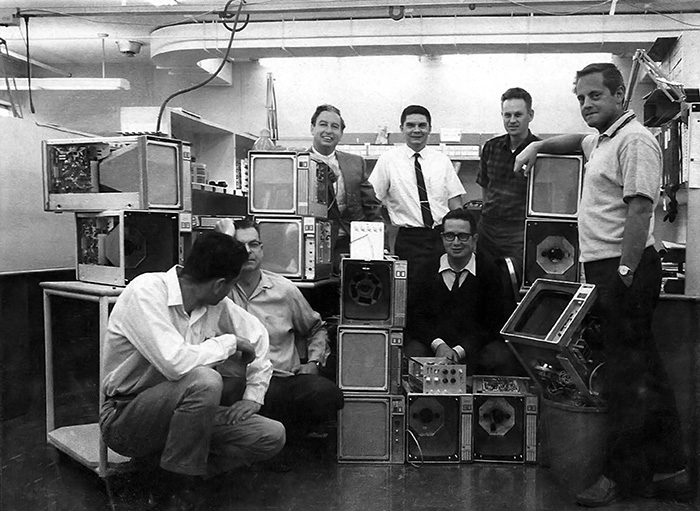 Feb 2024 POM: 611 team L to R: Joe Abid, Leo Heinick, Norm Winningstad, Stu McNaughton, Carlo Infante, Dan Denham, and Walt Lowy.
Feb 2024 POM: 611 team L to R: Joe Abid, Leo Heinick, Norm Winningstad, Stu McNaughton, Carlo Infante, Dan Denham, and Walt Lowy.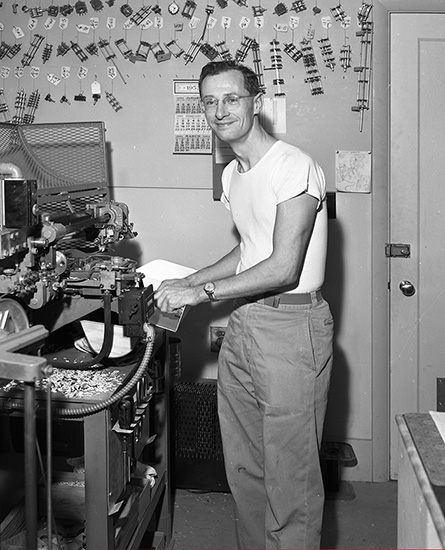 Mar 2024 POM: Employee making wafer switches at Sunset 1953
Mar 2024 POM: Employee making wafer switches at Sunset 1953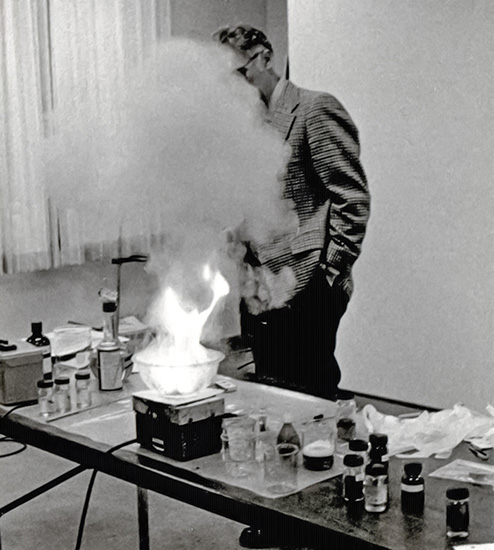 April 2024 POM: Chet Shink performing a safety demonstration
April 2024 POM: Chet Shink performing a safety demonstration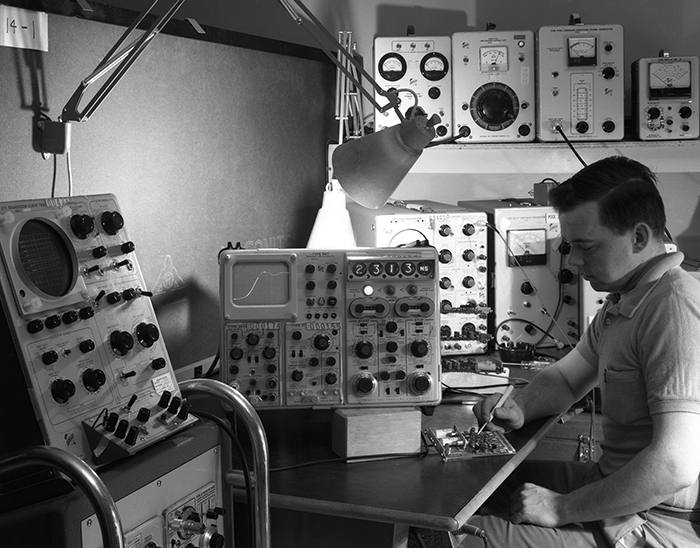 May 2024 POM: A 567 oscilloscope on a well-stocked engineering bench
May 2024 POM: A 567 oscilloscope on a well-stocked engineering bench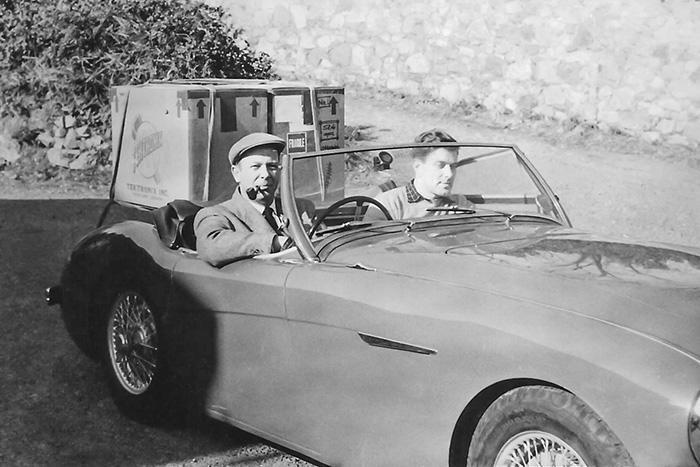 June 2024 POM: Al Hannmann transporting Tektronix products on his Austin Healey 100-4 luggage rack.
June 2024 POM: Al Hannmann transporting Tektronix products on his Austin Healey 100-4 luggage rack.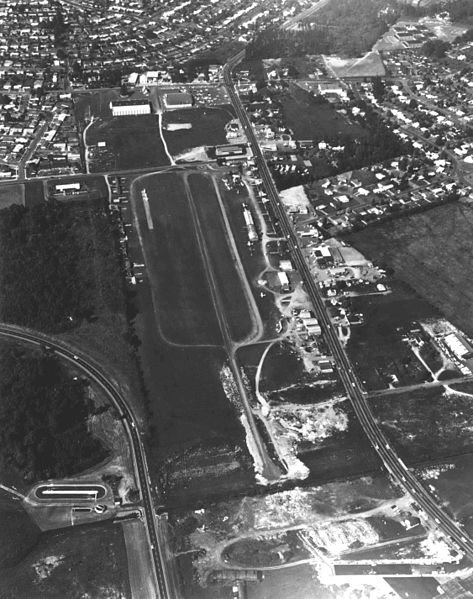 July 2024 POM: Bernard’s Airport directly east of the Tek Beaverton Campus 1966
July 2024 POM: Bernard’s Airport directly east of the Tek Beaverton Campus 1966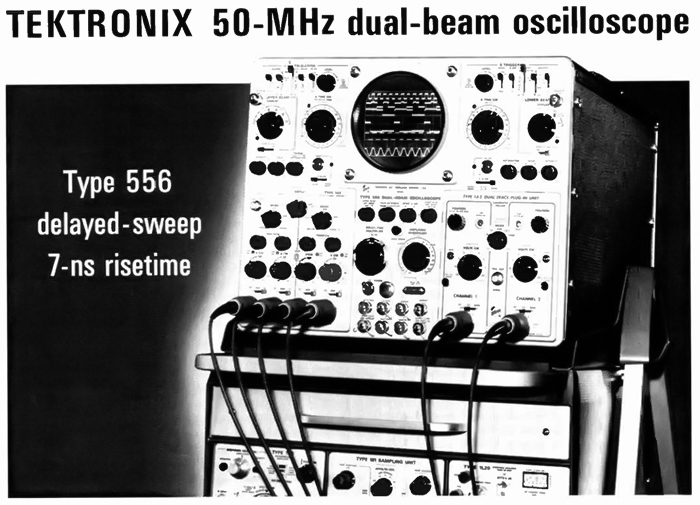 August 2024 POM: 556 advertisement from the February 17, 1969 issue of Electronics
August 2024 POM: 556 advertisement from the February 17, 1969 issue of Electronics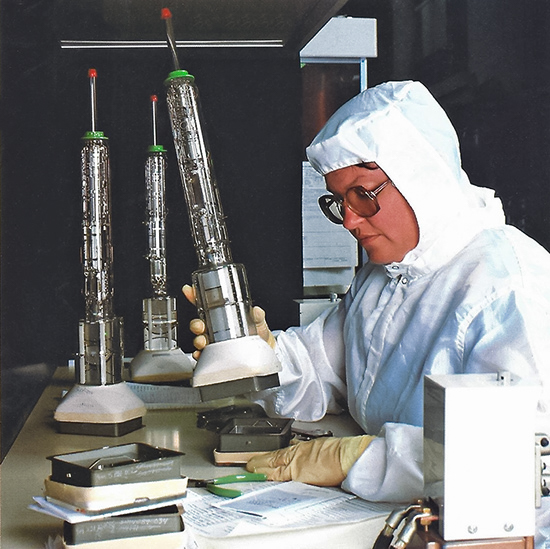 Sept 2024 POM: 1 GHz T7100 CRT being assembled in a clean room
Sept 2024 POM: 1 GHz T7100 CRT being assembled in a clean room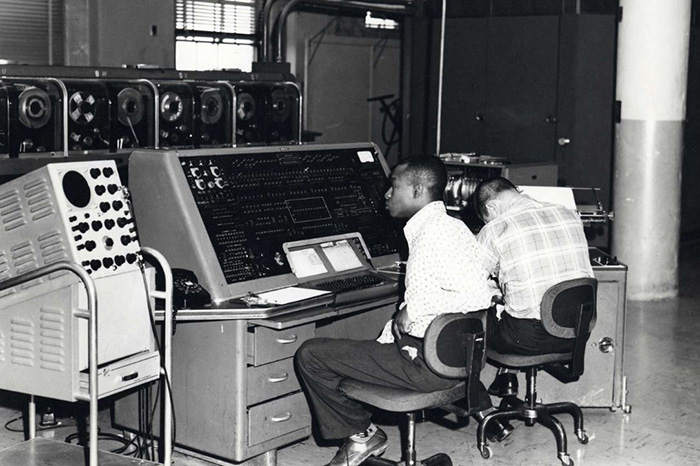 Oct 2024 POM: Type 511A used with UNIVAC I computer at US Census Bureau
Oct 2024 POM: Type 511A used with UNIVAC I computer at US Census Bureau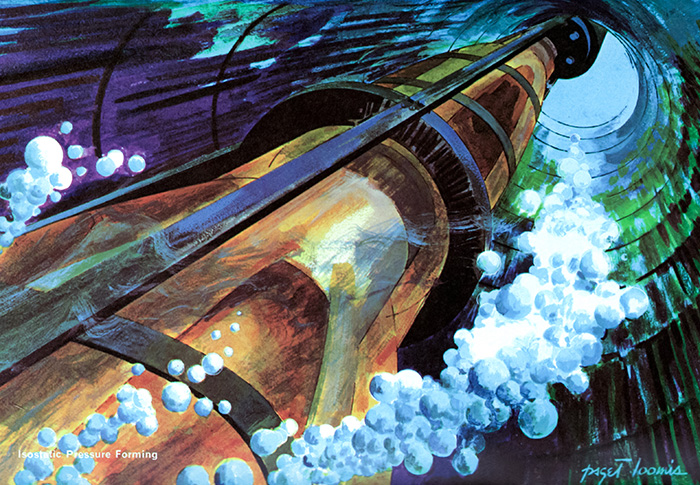 Nov 2024 POM: Painting of the inside of the isostatic ceramic CRT press from the 2025 vintageTEK calendar
Nov 2024 POM: Painting of the inside of the isostatic ceramic CRT press from the 2025 vintageTEK calendar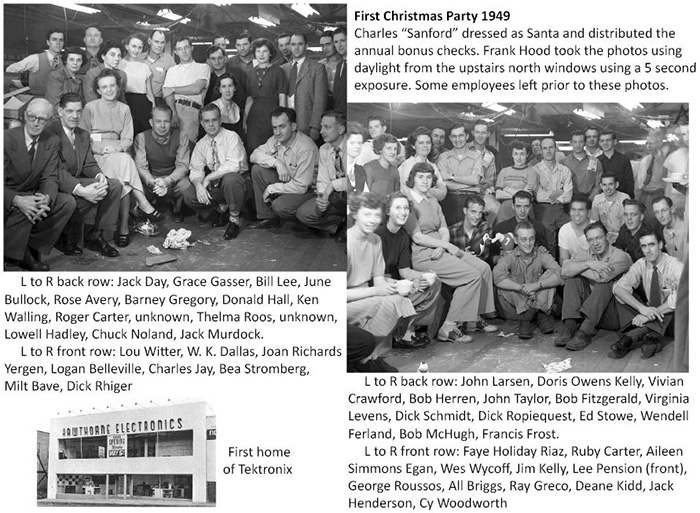 Dec 2024 POM: Photos of the first Christmas party 1949
Dec 2024 POM: Photos of the first Christmas party 1949

